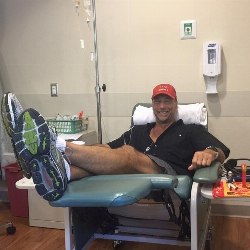Skin Cancer
The skin is an essential organ of the body that completely covers each individual. This organ helps to protect the body from the elements and is a natural defence barrier.
The skin allows to feel the sensation of touch which itell us if we are experiencing pain and other sensations of contact.
It consists of three layers:
- The epidermis is the external part of the skin that is a barrier against elements such as UV rays or any other aggression external to the body. Keratinocytes represent 80% of the cellular population of the epidermis.
- The dermis, located below the epidermis, ensures the hydration and nutrition of the skin. The dermis also protects the body against foreign bodies.
- The hypodermis is the last layer of the skin and contains the adipocytes (fat cells). Its role is essentially to insolate, so that the body stays warm.
The different forms of skin cancer
Skin carcinoma
Skin carcinomas occur most often after the age of 50 and are the most common form of skin cancer. Each year 200,000 new cases are discovered. Slowly progressing, these cancers are found on the superficial part of the skin, the epidermis. They often occur in areas affected by sunburn, such as arms, shoulders, neck, back and hands.
In general they are benign and easily treatable if detected in time.
Skin melanoma
The second form of skin cancer, which is much more aggressive, is skin melanoma. It can affect both young people and adults and has no specific location. Its evolution can be very rapid.
It can be recognized by the development of a pigmented spot on the skin that looks like a mole. In nearly 80% of melanoma cases, the abnormal mole (bright colour, irregular shape and contours, increasing size) has recently appeared.
A change in colour and shape of an existing mole can be a sign of skin melanoma. Bleeding and brightly coloured lesions appear and persist. Concerning your hands and nails, melanoma is characterized by the presence of a new brown band under the nail.
Men and women are not equal facing skin cancer. Indeed, women are diagnosed earlier (58 years old compared to 60 for men) but their 5-year survival rate is better than that of men: 89% compared to 83%. It should also be noted that melanoma is a cancer whose incidence is constantly increasing.
Causes of skin cancer
Skin cancer has several factors that contribute to its onset, including:
- Ultraviolet rays, whether artificial or natural (sun): protect yourself with sunscreen, avoid exposure to the sun during the hottest hours of the day and do not use sun beds.
- Melanoma history. A family background can predispose someone to skin cancer, as well as a personal history of melanoma.
- The amount of moles the person has. The more numerous they are, the greater the risk of melanoma: watch your moles and consult a dermatologist or health professional as soon as one of them has a heterogeneous colour, irregular edges and a diameter of more than 5 millimetres.
- The skin type (phototype). The lighter the skin and hair, the greater the risk of triggering melanoma.
People who understand these risk factors are advised to refer them to their doctor. The latter will then assess whether or not it is necessary to have a specific care. A dermatological consultation may, for example, be prescribed. Prevention is also a way to limit the extent of risk factors. It is sometimes recommended to have regular medical check-ups and self-monitoring.
Skin cancer treatments
The choice of treatment for skin cancer depends on the stage of melanoma development, its location and the patient's state of health (age, physical condition). In addition, patient input and multidisciplinary discussion among health professionals are fully integrated into the treatment choice process.
The eradication of melanoma, stopping its proliferation, reducing the likelihood of relapse, and reducing skin cancer pain and symptoms to ensure better comfort for patients are all different goals that skin cancer treatments offer.
Surgery is the main option for treating skin cancer. It allows the melanoma to be removed when it is located. As a complementary treatment, immunotherapy is proposed to limit the probability of cancer relapse. These two combined treatments are proposed in stages I and II of skin cancer.
Stage III corresponds to an extensive skin melanoma with similar metastases. To treat it, surgery is first performed. As an adjuvant treatment, immunotherapy is proposed. It is done by alpha interferons and its objective is to reduce the risk of recurrence as much as possible. External radiotherapy is another complementary treatment to surgery.
If it is impossible to perform surgery to remove the melanoma, chemotherapy is an option available.
If melanoma is spread with distant metastases (stage IV), available treatments are surgery, immunotherapy and chemotherapy. In particular, external radiotherapy and chemotherapy are proposed as palliative treatment. This means that their objective is to limit the development of skin cancer and reduce related symptoms (pain...).
More rarely, the following treatments can be proposed:
- the destruction of metastases by radiofrequency: it is the destruction of cancer cells by the application of waves that emit very high heat.
- Cryosurgery of liver metastases. This local treatment of metastases is limited to the introduction of needles that will freeze the tumor in intense cold.
- Chemotherapy on an isolated limb.
Published 8 Sep 2019
Skin cancer community
Breakdown of 61 members on Carenity
Average age of our patients
Fact sheets
See more



